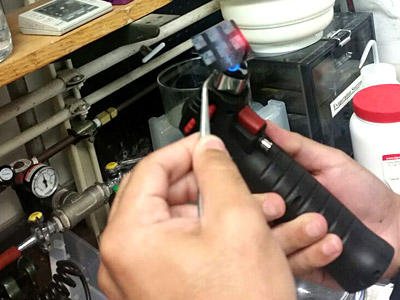
A few months ago, Luis Rubio was facing a difficult decision.
The Elmhurst senior had received invitations to spend his summer as an undergraduate researcher in science labs at two of the world’s most renowned research institutions, Harvard and the University of Chicago.
Either one of the two offers would have been cause for celebration for most science majors. But to have to decide between two such prestigious posts? Now that was a problem.
“My friends kept telling me it was a good problem to have,” Rubio joked recently. “But I was really torn between the two.”
Rubio, a double major in physics and chemistry, was speaking from Harvard’s campus in Cambridge, Massachusetts, where after lengthy deliberation, he had opted to accept a 10-week posting as part of the Research Experiences for Undergraduates (REU) program, sponsored by the National Science Foundation.
At Harvard, Rubio worked in the sprawling, multidisciplinary lab of George Whitesides, perhaps the best-known and most prolific of the world’s chemists. (Whitesides’ Hirsch Index number, which measures scholarly output and the number of times work is cited by other researchers, is the highest of any living chemist.) Rubio worked with postdoctoral researchers in the lab on projects in soft lithography—a nanotechnology pioneered by Whitesides that produces structures on a very small scale in much the same way traditional photolithography is used to make computer chips. (Nanotechnology works in dimensions of fewer than 100 nanometers. A bit of perspective: A sheet of paper is 100,000 nanometers thick.)
Rubio’s project involved using transparent silica beads as micro-lenses that, when exposed to ultraviolet light, can etch nano-patterns into silicon wafers. Such soft lithographic techniques offer cost and time savings over traditional photolithography.
The nanotechnology being developed in Whitesides’ lab lends itself to diverse applications. In one of its many projects, the lab has developed a thumbnail-sized paper “chip” embedded with electrochemical sensors that analyze the merest drops of blood or other fluid for signs of infectious diseases or chronic conditions. Said to be as accurate as any conventional lab, it offers a low-cost, portable diagnostic tool even where medical facilities are lacking.
Taking a break from working on an end-of-summer paper and presentation on his project, Rubio said he chose to work at Harvard because it offered a chance for his first extended stay outside his native Chicago area. The decision turned out to be a good one. He enjoyed exploring Cambridge and Boston during his free time, and his work in the lab helped him grow as a scientist.
“It has been a very cool experience,” he said. “I’m learning to think through problems and find the information I need. It’s like I had training wheels on before, but now they’re starting to come off.”
He admitted, though, that he had some initial misgivings about the hyper-intellectual environment.
“I was worried that I’d meet nothing but super-level geniuses here, that everyone would be so bright that I couldn’t stack up,” he said. “It’s true that everyone is very intelligent, but they’re also down to earth. They’ve made me feel like I belong.”
Rubio laughs that his “nerdy grade-school friends” in West Chicago should get credit for fostering his boyhood interest in science. But he says that for all his scientific curiosity, he remained an unmotivated student through much of grade school and high school. “I had a slacker attitude,” he said.
That changed when, after a year and a half at the College of DuPage, Rubio transferred to Elmhurst. “I got serious,” he said. A chemistry major, he began thinking about his post-graduation options. “I started to see that medical school could be a real possibility for me.”
He added a physics major after taking a introductory physics class with Assistant Professor Venkatesh Gopal. “I’d always been interested in physics, but I thought I lacked the ability to do it,” Rubio said. “I give him credit for helping me break down that barrier, and giving me the confidence to think about science as something I could do.”
The Harvard research experience was not Rubio’s first summer science job. In 2013, he worked on a similar National Science Foundation–funded REU in chemistry at the University of Illinois at Chicago.
Rubio keeps busy with more than his double science major. A member of the College’s cross-country team and a resident adviser in West Hall, he’s active in the Chemistry Club and HABLAMOS, the Latino student group. He is also busy planning his life beyond graduation. He has already begun applying to medical schools, but says that he is also interested in graduate study in biomedical engineering.
Whatever he decides to do, Rubio said, his Harvard experience should prove valuable. And now that he has those training wheels off, there is no telling where he can go.